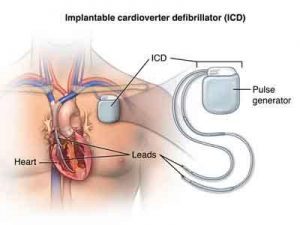- Home
- Editorial
- News
- Practice Guidelines
- Anesthesiology Guidelines
- Cancer Guidelines
- Cardiac Sciences Guidelines
- Critical Care Guidelines
- Dentistry Guidelines
- Dermatology Guidelines
- Diabetes and Endo Guidelines
- Diagnostics Guidelines
- ENT Guidelines
- Featured Practice Guidelines
- Gastroenterology Guidelines
- Geriatrics Guidelines
- Medicine Guidelines
- Nephrology Guidelines
- Neurosciences Guidelines
- Obs and Gynae Guidelines
- Ophthalmology Guidelines
- Orthopaedics Guidelines
- Paediatrics Guidelines
- Psychiatry Guidelines
- Pulmonology Guidelines
- Radiology Guidelines
- Surgery Guidelines
- Urology Guidelines
Cardiac resynchronization therapy with CRT defibrillator may benefit more heart failure patients

Certain groups of heart failure patients may see improved heart function with cardiac resynchronization therapy with defibrillator (CRT-D) if traditional implantable cardioverter defibrillator treatment does not work, according to research published in the Journal of the American College of Cardiology.
There are three types of conduction disorders, and until now, most research on CRT therapy in heart failure patients has focused on the most common, called left bundle branch block (LBBB). This is a heart conduction abnormality seen on the electrocardiogram (EKG). In this condition, activation of the left ventricle of the heart is delayed, which causes the left ventricle to contract later than the right ventricle.
The new study focused on two less common conduction disorders: right bundle branch block (RBBB) and nonspecific intraventricular conduction delay (NICD)--together, often referred to as "non-LBBB"--to determine the benefit of CRT-D.
A CRT-D is a special device for heart failure patients who are also at high risk for sudden cardiac death. While functioning like a normal defibrillator (called an implantable cardioverter defibrillator, or ICD) to treat slow heart rhythms and life-threatening fast heart rhythms, a CRT-D device also delivers small electrical impulses to the left and right ventricles to help them contract at the same time. This helps the heart pump more efficiently.
"CRT is known to improve heart function in patients with LBBB, but until now we have not had enough evidence to support use of CRT in patients with either RBBB or NICD," said lead researcher Hiro Kawata, MD, PhD, of the Oregon Heart and Vascular Institute in Springfield. "Current guidelines state that when patients with heart failure and non-LBBB conduction disorder continue to suffer symptoms such as shortness of breath or fatigue even after medical therapy, CRT can be tried as a next step, even though there is a lack of evidence about its effectiveness in these patients. We wanted to find out whether CRT can help non-LBBB patients."
Kawata and colleagues evaluated data between 2010-2013 from the NCDR ICD Registry, the national standard for understanding patient selection, care and outcomes in patients receiving ICD therapy.
The researchers divided patients with RBBB and NICD into two groups according to the length of their QRS, or waves on an EKG that represent how long it takes to conduct electricity through the lower ventricle of the heart. A QRS longer than 120 milliseconds represents a conduction abnormality.
"In patients with LBBB, the longer the QRS, the more likely you are to respond to CRT," Kawata said. "We wanted to find out whether this was also true in patients with non-LBBB conduction disorders."
The study compared patients who had one of two types of defibrillator - either a CRT-D or an ICD.
Among 5,954 Medicare-aged patients with NICD or RBBB who were implanted with a defibrillator, the study found patients with NICD and a QRS of more than 150 milliseconds responded best to CRT-D. In these patients, CRT-D was associated with decreased risk of death, readmission to the hospital for any cause, as well as readmission for heart-related causes, compared with a similar group of patients implanted with ICD. Among patients with RBBB, CRT-D was not associated with better outcomes compared with ICD, regardless of the duration of their QRS.
"This means that if you have a patient with RBBB who is still suffering from heart failure symptoms after medical therapy, there is not enough data to support using CRT blindly," Kawata said. "But in NICD patients, we now know that those with a long QRS are likely to benefit from CRT."
He said more study is needed to establish whether certain RBBB patients might respond to CRT.
"While implanting a CRT-D is relatively safe, it is not without risks," Kawata said.
CRT can cause complications, including infection, a pneumothorax (punctured lung) or cardiac perforation (perforated heart muscle), he said.
In an editorial accompanying the study, Michael Gold, MD, PhD, of the Medical University of South Carolina in Charleston, noted the results from this study provide important data indicating that not all non-LBBB types, or morphologies, are the same.
"The authors should be commended for providing more detailed analysis of the electrocardiogram and not simply using what is now the conventional LBBB vs non-LBBB morphologies," he said. "These findings will need to be confirmed with further studies, either from prospective trials or pooled data from previous randomized trials. However, importantly, the results of the present study challenge our convention of lumping CRT candidates into two categories."
For more details click on the link: http://dx.

Disclaimer: This site is primarily intended for healthcare professionals. Any content/information on this website does not replace the advice of medical and/or health professionals and should not be construed as medical/diagnostic advice/endorsement or prescription. Use of this site is subject to our terms of use, privacy policy, advertisement policy. © 2020 Minerva Medical Treatment Pvt Ltd